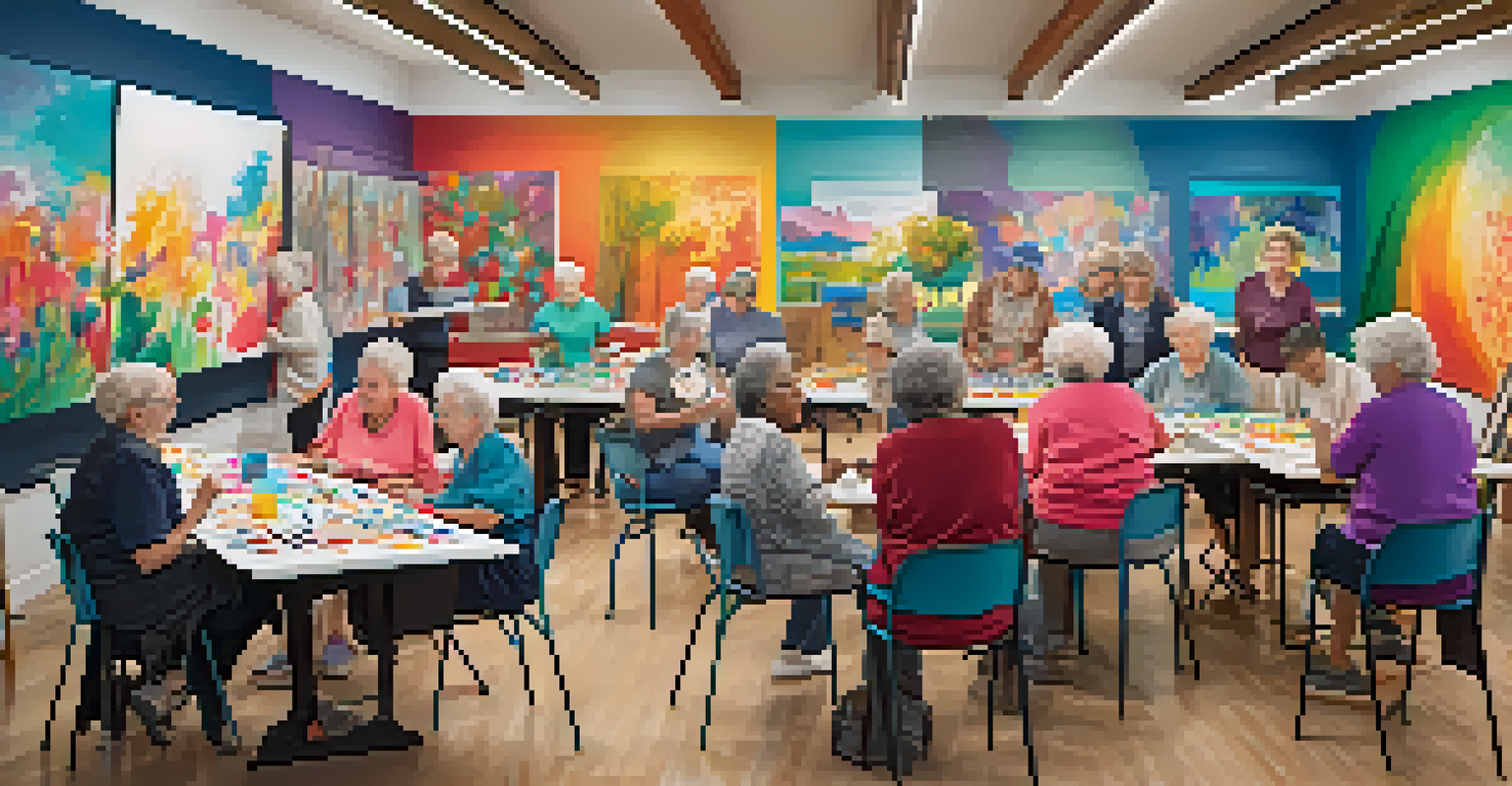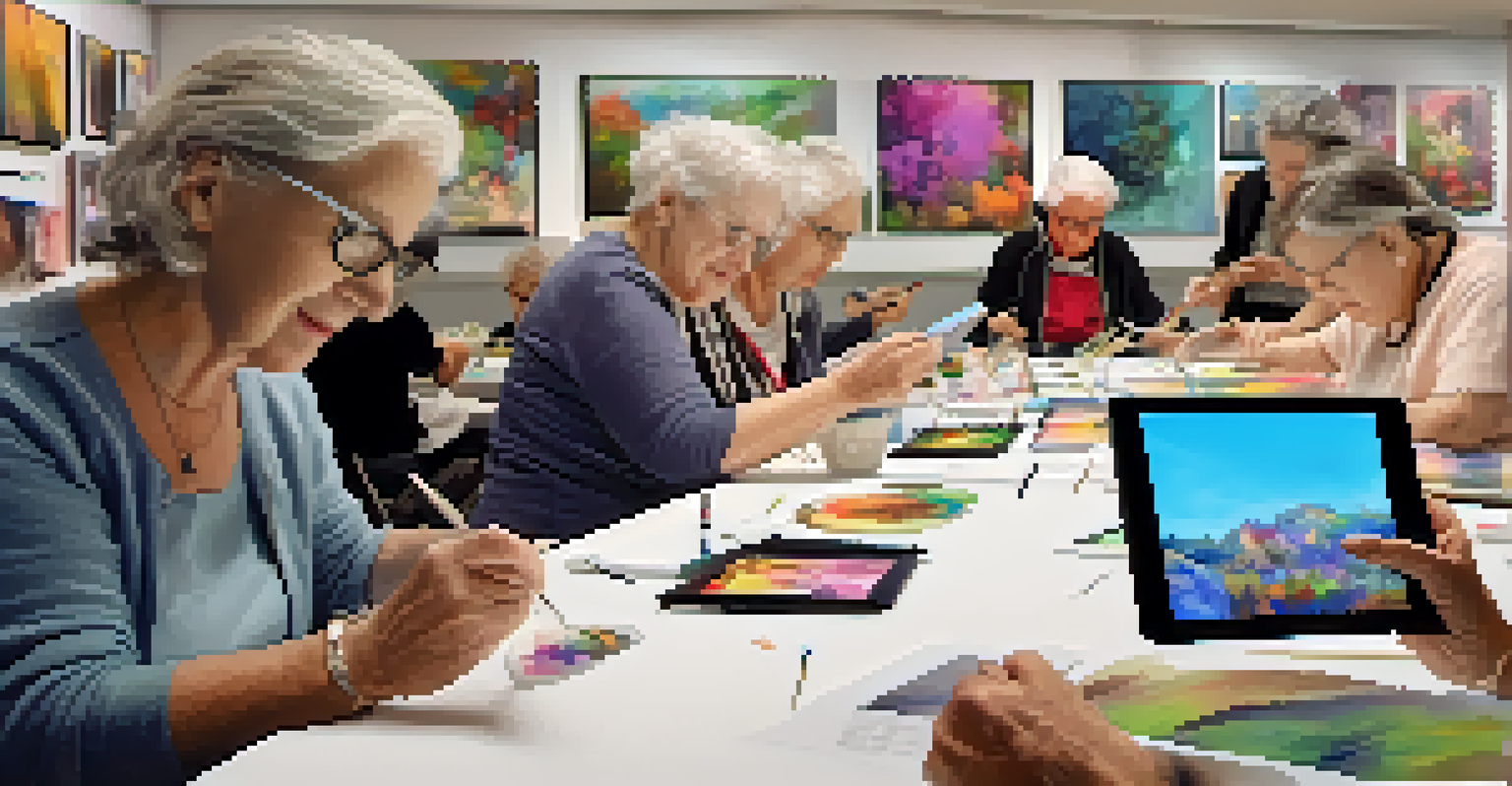Art and Aging: Understanding the Emotional Landscape

The Connection Between Art and Emotional Well-Being
Art has a unique ability to express feelings that often go unspoken. For many seniors, engaging with art can serve as a powerful outlet for emotions, providing a way to process life experiences. Whether it's painting, sculpting, or even photography, these creative activities can significantly enhance emotional well-being.
Art is the most beautiful of all lies.
Research indicates that participation in the arts can lead to improved mental health outcomes. Activities like art therapy help to reduce anxiety and depression, allowing older adults to find joy and fulfillment. By creating or appreciating art, seniors can connect with their emotions and share their stories.
Moreover, art can foster a sense of community among seniors. Group classes or workshops not only allow for creative expression but also encourage social interaction, combating feelings of isolation that can often accompany aging. In this way, art becomes a bridge that connects individuals, fostering emotional support and companionship.
Art as a Medium for Reflection and Memory
As we age, memories can become fragmented or difficult to access. Art provides a tangible way to reconnect with these memories, serving as a catalyst for reflection. Creating or engaging with art can trigger recollections of past experiences, helping seniors to reminisce and share their life stories.

For instance, a simple painting of a landscape may evoke memories of a childhood home or a significant life event. This process of reflection can be incredibly therapeutic, allowing seniors to confront emotions tied to those memories. It can also promote a sense of continuity in life, reinforcing their identity and life narrative.
Art Enhances Emotional Well-Being
Engaging with art provides seniors a powerful outlet for emotions, improving mental health and reducing feelings of isolation.
Additionally, art can be a means of preserving memories for future generations. By creating artworks that encapsulate their experiences, seniors can share their legacies with family and friends. This act of creation not only honors their past but also provides a sense of purpose in the present.
Creative Expression as a Tool for Coping
Aging often comes with its own set of challenges, including health issues and loss of loved ones. Art can serve as a powerful coping mechanism during these difficult times. Engaging in creative activities allows seniors to process their feelings and find solace in expression.
Art enables us to find ourselves and lose ourselves at the same time.
For example, someone dealing with grief might find comfort in painting or writing poetry. These creative outlets provide a safe space to explore complex emotions without judgment. This not only aids in emotional healing but also fosters resilience through self-expression.
Moreover, the act of creating something tangible can instill a sense of accomplishment. This feeling of achievement can be especially uplifting for seniors, reminding them of their capabilities and talents. In this way, art becomes a beacon of hope in the face of life's uncertainties.
The Role of Art in Social Engagement
Participating in art-related activities can significantly enhance social engagement among seniors. Whether it's joining a local art class or attending gallery exhibitions, these events create opportunities for interaction and connection. Shared interests in art can spark conversations and foster friendships.
The importance of social connections cannot be overstated, especially for older adults who may experience loneliness. Engaging with others through art provides a sense of belonging and community. This socialization is crucial for emotional health, as it combats feelings of isolation and loneliness.
Art as a Tool for Reflection
Creating or engaging with art helps seniors reconnect with memories and promotes therapeutic reflection on their life experiences.
Furthermore, collaborative art projects can enhance teamwork and communication skills. Working together on a piece of art allows seniors to bond over shared experiences and challenges, enriching their social lives while creating something beautiful. This reinforces the idea that art is not just an individual pursuit but a collective experience.
Art Therapy: A Professional Approach to Healing
Art therapy is a structured approach that combines psychology and creative expression to promote healing. Trained art therapists work with seniors to help them explore their emotions and cope with challenges through artistic activities. This professional guidance can be particularly beneficial for those facing mental health issues.
During sessions, individuals are encouraged to create art that reflects their feelings, which can lead to breakthroughs in understanding their emotional states. The therapeutic process allows seniors to explore difficult topics in a safe and supportive environment. It’s an empowering way to facilitate self-discovery and healing.
Moreover, art therapy can be tailored to meet the unique needs of each individual. Whether working with those experiencing dementia or depression, the flexibility of this approach ensures that everyone can benefit from the therapeutic power of art. By integrating creativity with professional support, art therapy offers a holistic path to emotional well-being.
Art and Cultural Identity in Aging
Art often serves as a reflection of cultural identity, especially for older adults who have lived through significant historical events. Engaging with art can help seniors connect with their cultural heritage, fostering a sense of pride and belonging. This connection can be particularly important in a multicultural society.
For example, seniors may find joy in creating traditional crafts or participating in cultural exhibitions that celebrate their backgrounds. These activities not only honor their past but also provide a platform for sharing their experiences with younger generations. This intergenerational exchange can be enriching for both parties.
Social Connections Through Art
Participation in art activities fosters social engagement, combatting loneliness and enriching community ties among older adults.
Additionally, exploring different art forms from various cultures can broaden perspectives and encourage empathy. By appreciating diverse artistic expressions, seniors can engage with the world around them, reinforcing their sense of community and shared humanity. This cultural engagement helps to maintain a vibrant emotional landscape throughout the aging process.
Technology and Art: New Avenues for Expression
The integration of technology in the arts has opened up new possibilities for creative expression among seniors. Digital tools and platforms allow older adults to explore art in innovative ways, from digital painting to virtual galleries. These technologies make art more accessible and engaging.
Online platforms also facilitate connections with artists and art enthusiasts across the globe. Seniors can participate in virtual workshops or share their artwork on social media, expanding their creative community. This engagement can be both inspiring and motivating, encouraging continued exploration of their artistic talents.

Moreover, technology can aid in preserving and sharing art. Seniors can document their creations digitally, creating a portfolio that showcases their artistic journey. This not only honors their creative efforts but also provides a sense of accomplishment, reinforcing the importance of art in their lives.